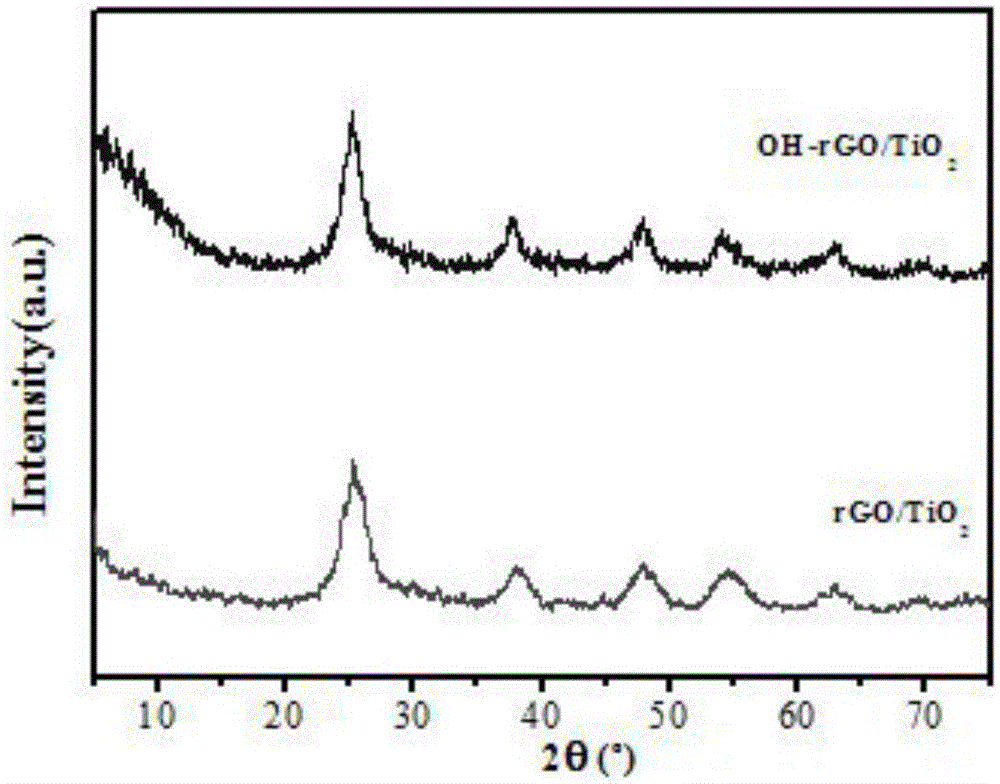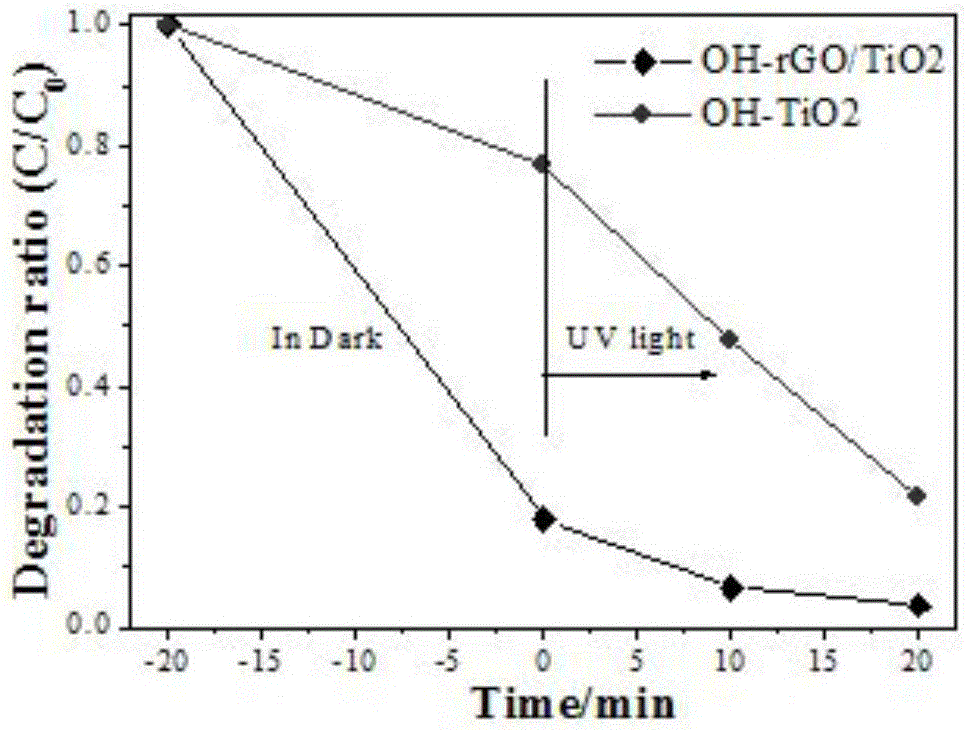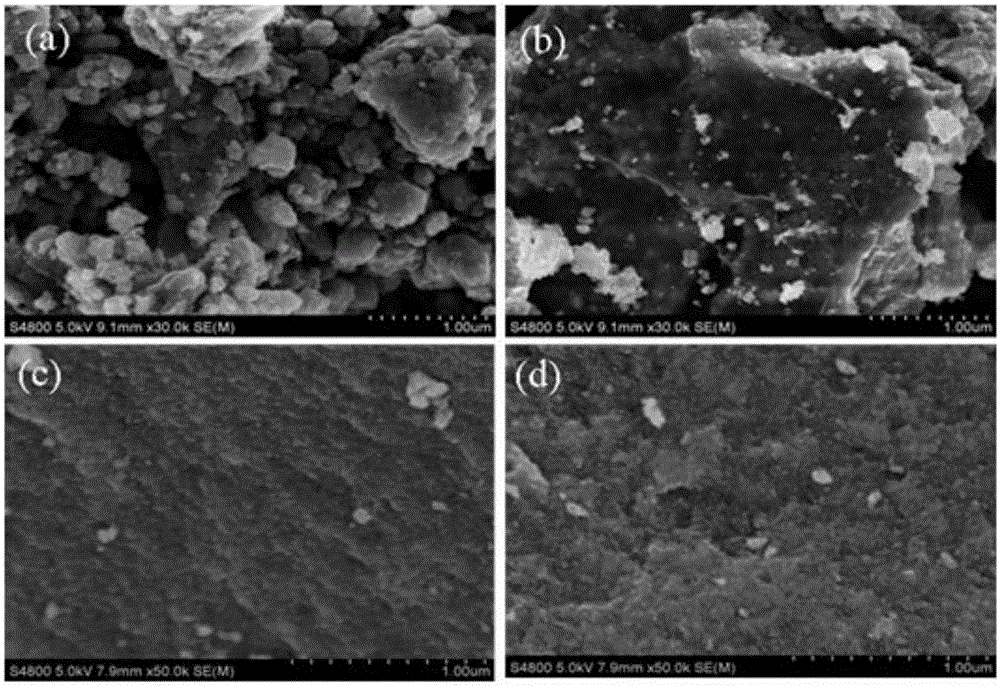Preparation method of hydroxylation titanium oxide/graphene visible light catalysis material
A technology for hydroxylating titanium oxide and catalytic materials, applied in the field of photocatalytic materials, can solve the problems of limited spectral response range, no photocatalytic activity, unfavorable large-scale production, etc. The effect of absorption properties
- Summary
- Abstract
- Description
- Claims
- Application Information
AI Technical Summary
Problems solved by technology
Method used
Image
Examples
Embodiment 1
[0034] (1) Add 20 mL of reduced graphene oxide solution with a concentration of 1.2 g / L into 20 mL of ultrasonic dispersion for 30 min to obtain a graphene dispersion;
[0035] (2) Dissolve 2 mL of acetic acid, 4 mL of titanium salt, and 0.05 g of polyacrylic acid in 20 mL of ethanol in turn, and then add 20 mL of deionized water in which 3 mL of 1.0 mol / L ammonium nitrate is dissolved to obtain a transparent solution a;
[0036] (3) Drop the above graphene dispersion into the transparent solution a, and ultrasonically stir for 10 min at 25°C to obtain a uniformly dispersed brown solution b; wherein, 40 mL of deionized water is added to the samples 1 and 2 to replace the graphene dispersion;
[0037] (4) Drop 32.8 mL of NaOH with a concentration of 1.0 M into the uniformly dispersed brown solution b, adjust the pH to 3.2, and stir and ultrasonically disperse for 5 minutes to obtain a uniformly dispersed gray solution c;
[0038] (5) Place the uniformly dispersed gray solution ...
Embodiment 2
[0044] (1) Add 6 mL of graphene oxide solution with a concentration of 2 g / L into 20 mL of deionized water for ultrasonic dispersion for 30 min to obtain a graphene dispersion;
[0045] (2) Dissolve 1 mL of acetic acid, 2 mL of titanium salt and 0.05 g of CTAB in 20 mL of ethanol in turn, then in 10 mL of ethanol, and then add 40 mL of deionized water in which 2 mL of 65% concentrated nitric acid is dissolved to obtain a transparent solution a;
[0046] (3) drop the above graphene dispersion into the transparent solution a, and ultrasonically stir for 10 min at 25°C to obtain a uniformly dispersed brown solution b;
[0047] (4) Drop 32.8 mL of NaOH with a concentration of 1.0 M into the uniformly dispersed brown solution b, adjust the pH to 3.2, and stir and ultrasonically disperse for 5 minutes to obtain a uniformly dispersed gray solution c;
[0048] (5) Place the uniformly dispersed gray solution c in a water bath at 60°C for 30 minutes at a constant temperature, and stir a...
Embodiment 3
[0055] (1) Add 8 mL of reduced graphene oxide solution with a concentration of 2 g / L into 20 mL of deionized water for ultrasonic dispersion for 30 min to obtain a graphene dispersion;
[0056] (2) Dissolve 1 mL of acetic acid, 2 mL of titanium salt and 0.05 g of sodium polyacrylate in 10 mL of ethanol in turn, and then add 20 mL of deionized water in which 3 mL of 2.0 mol / L sodium nitrate is dissolved to obtain a transparent solution a;
[0057] (3) drop the above graphene dispersion into the transparent solution a, and ultrasonically stir for 10 min at 25°C to obtain a uniformly dispersed brown solution b;
[0058] (4) dropping ammonia water with a concentration of 2.0M into the uniformly dispersed brown solution b, adjusting the pH to 3, and stirring and ultrasonically dispersing for 5 minutes to obtain a uniformly dispersed gray solution c;
[0059] (5) Place the uniformly dispersed gray solution c in a water bath at 60°C for 30 minutes at a constant temperature, and stir ...
PUM
 Login to View More
Login to View More Abstract
Description
Claims
Application Information
 Login to View More
Login to View More - R&D
- Intellectual Property
- Life Sciences
- Materials
- Tech Scout
- Unparalleled Data Quality
- Higher Quality Content
- 60% Fewer Hallucinations
Browse by: Latest US Patents, China's latest patents, Technical Efficacy Thesaurus, Application Domain, Technology Topic, Popular Technical Reports.
© 2025 PatSnap. All rights reserved.Legal|Privacy policy|Modern Slavery Act Transparency Statement|Sitemap|About US| Contact US: help@patsnap.com



